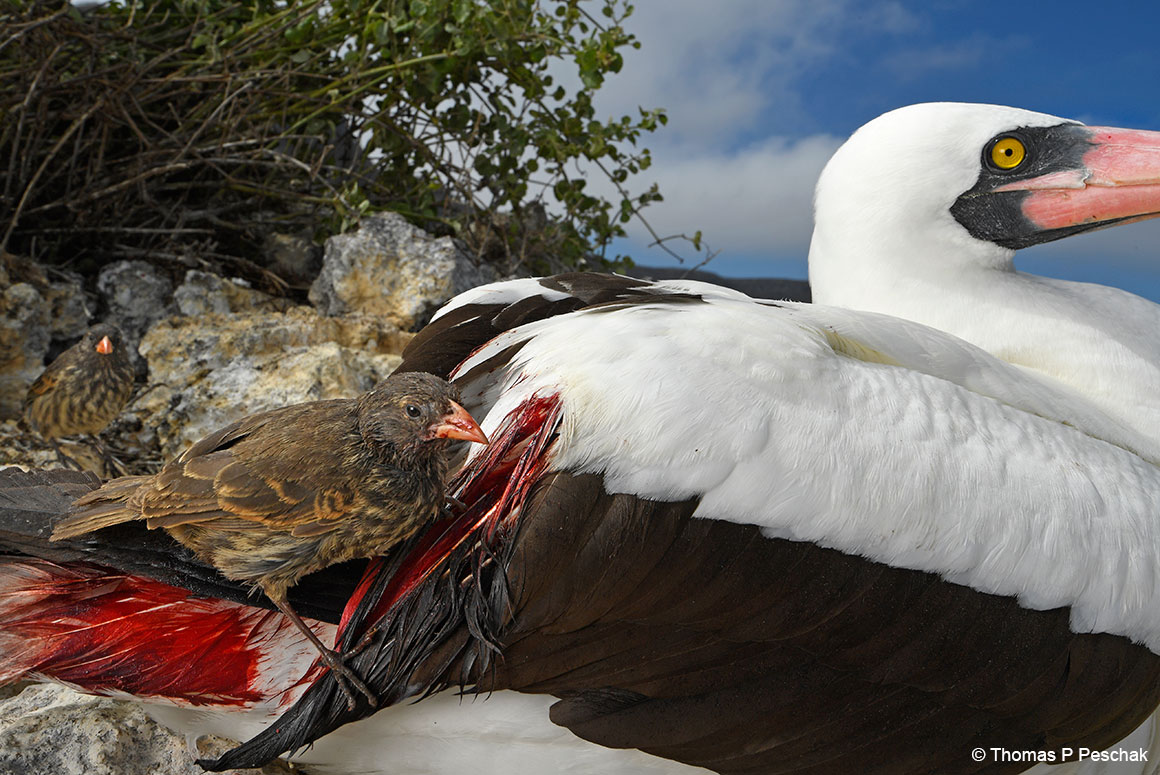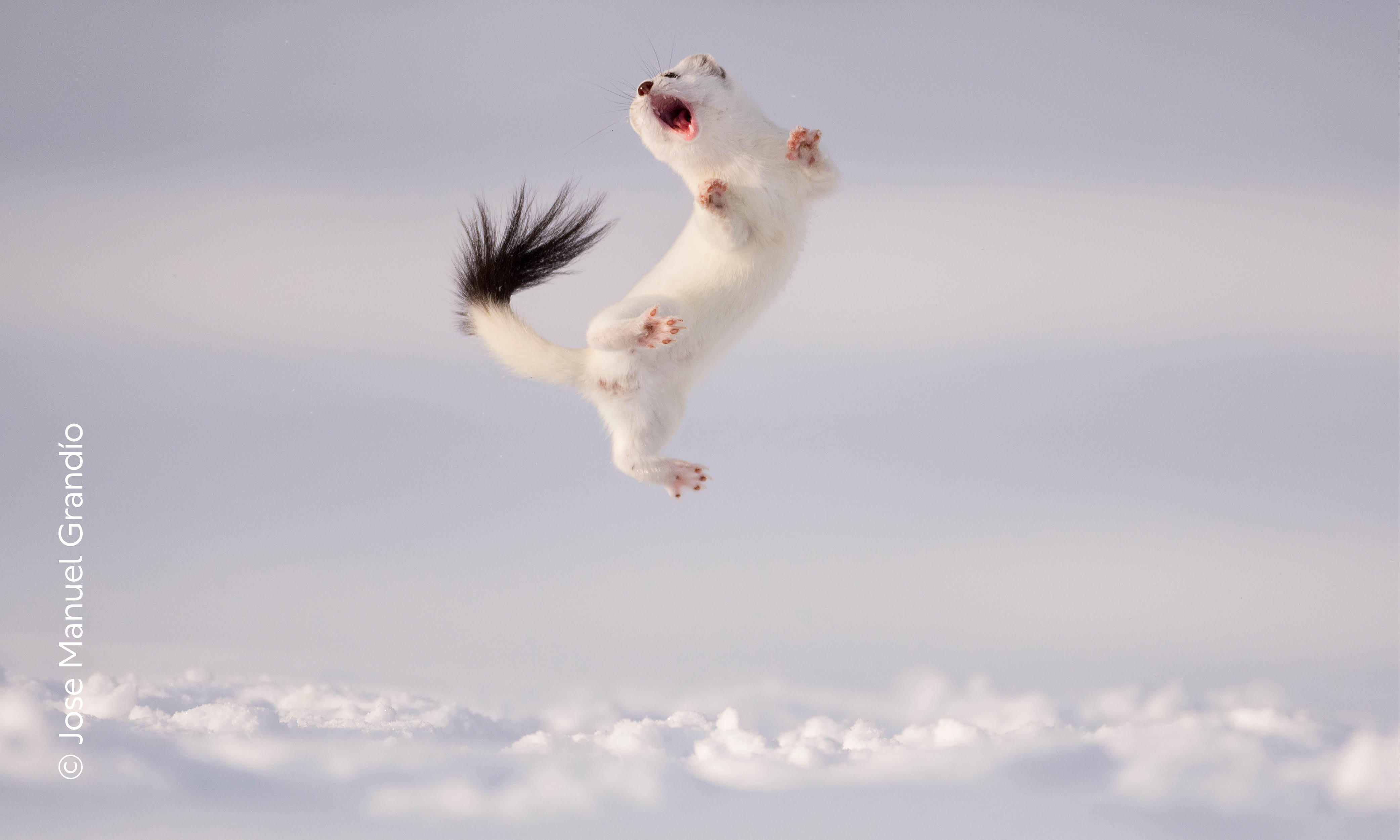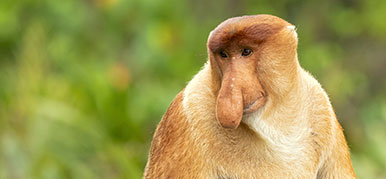What on Earth?Wildlife Photographer of the Year: blood-loving birds of the Galápagos
Wolf Island, in the Galápagos, is remote and rarely visited. But this volcanic island is home to an unusual group of birds: vampire ground finches.
Photographer Thomas P Peschak had the rare opportunity to visit the island and witness the blood-drinking behaviour of these sharp-beaked birds.
'Wolf Island is truly wild,' says Thomas P Peschak, winner of Wildlife Photographer of the Year 54 Behaviour: Birds category.
The isolated island, located in the northwest of the Galápagos archipelago, is often shrouded in mist, its rocky cliffs are exceptionally steep and there is no permanent freshwater source.
'This is a harsh place to survive, unless you are a seabird which can get food from the rich adjacent ocean,' he explains.
But finches are not seabirds and instead of a seafood diet, these small birds have to utilise other resources in their unforgiving environment. Dr Alex Bond, Senior Curator of Birds at the Museum explains the most extreme feeding strategy of all of Darwin's finches.
The vampires of Wolf Island
Nazca boobies (Sula granti) are abundant on Wolf Island (also known as Wenman Island), using it as a breeding ground. They feed by diving at high speed into the surrounding ocean to capture small fishes. When they return to the island, they live in large colonies and nest amongst the dense cactus thickets.
But survival on Wolf Island is tougher for the ground finch species, Geospiza septentrionalis. These small birds are unable to leave the safety of the plateau to find food, but on the island there is no permanent water supply and it rarely rains. This species is also resident on Darwin Island, one of the smallest and the most north-westerly of the Galápagos Islands.
Galápagos finches are well-known - they are sometimes called Darwin's finches as they were first studied by the famous biologist during his voyage aboard HMS Beagle in the 1830s. Darwin's finches are a group in which each species has specially adapted beaks and behaviours to aid survival in their specific habitats, but are all descendants of a common ancestor.
The finches on Wolf and Darwin islands feed on seeds and insects. But their supply often runs out, especially during the dry season. This leaves them in need of another source of nutrition.
Finches may have once pecked at the feathers of Nazca boobies and other seabirds to feed on parasites, but this trait has developed into one that is unique to G. septentrionalis.
'They have become vampires,' says Thomas. 'I have seen more than half a dozen finches drinking from a single Nazca booby.'
The finches peck at the base of the seabirds' feathers until blood begins to flow, which they then lap up with their tongues. This behaviour has resulted in the common name of vampire ground finches.
The boobies appear tolerant of the vampire birds' behaviour, however. The beak-inflicted wounds and blood loss don't seem to cause the seabirds any significant or lasting damage.
A challenging location
Thomas captured his award-winning image, Blood Thirsty, on Wolf Island. The isolated island is the partial remains of an extinct volcano and was named after Franz Theodor Wolf, a German naturalist who studied the Galápagos Islands in the late-nineteenth century.
Wolf Island is so remote - and its cliffs so dangerous - that it had never been landed on until 1964, and only with the aid of a helicopter. There is no permanent population on the island and it is rarely visited by rangers and scientists, although the surrounding ocean is highly regarded for its dive sites such as El Derrumbe.
The island itself is closed to tourists. Thomas managed to secure a rare permit to set foot on Wolf Island thanks to his work on a Galápagos climate-change story.
Thomas originally trained as a marine biologist specialising in human-wildlife conflict. But he turned to photojournalism, finding images able to create a greater conservation impact.
He is now a National Geographic photographer, specialising in documenting the beauty and fragility of the oceans, islands and coastlines. Working alongside NGOs, Thomas has been able to effect change, for example the protection of Hanifaru Bay in the Maldives' Baa Atoll through his photography of its abundant manta rays.
Thomas is a veteran of Wildlife Photographer of the Year. In 2015 he was a finalist for The Wildlife Photojournalist Award with his image, The Shark Surfer and he won the Wildlife Photographer Portfolio Award in 2017 with a series of images captured in the remote Aldabra Atoll in the Seychelles.





Don't miss a thing
Receive email updates about our news, science, exhibitions, events, products, services and fundraising activities. We may occasionally include third-party content from our corporate partners and other museums. We will not share your personal details with these third parties. You must be over the age of 13. Privacy notice.
Follow us on social media